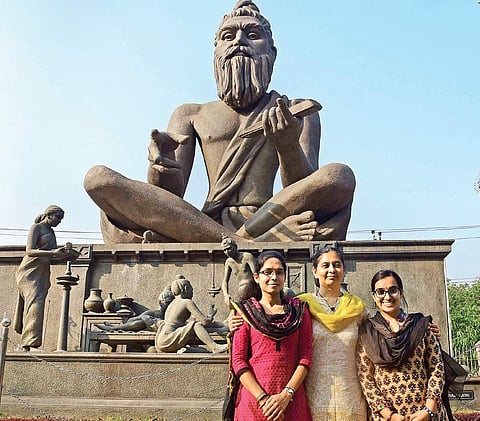

On October 9 last year—Mata Amritanandamayi's birthday—several stalls were put up at Amritapuri in Kollam, Kerala. One of them manned by 19-year-old Swadha Dwivedi was selling reusable sanitary pads. Soon, a middle-aged man came up and said, “How did you come up with this idea?”
Swadha felt embarrassed and said, “This stall is only for women.”
The man said, “You are being discriminatory. You can tell men, too.” Later, when Swadha told Mata Amritanandamayi about this, the latter said, “There is no problem in talking about pads with a man. You shouldn’t feel shy. You must help end the stigma around menstruation.”
The pad in question is called Saukhyam—a Sanskrit word that means happiness and well-being. Keeping the factors like cost and environment in mind, Amrita Self-Reliant Village (SeRVe) came up with pads made of banana fibre. “It is a naturally occurring absorbent with medicinal properties. Nobody has used banana fibres to make reusable pads. Amma wanted us to do this,” says Anju Bist, co-director, Amrita SeRVe.
Apart from providing a means of personal hygiene to women, these pads have become a source of income for rural women, who manufacture them under the guidance of Mata Amritanandmayi.
First, the stalk is cut. Then it is put into an extractor machine, where it is converted into thin strips. “These have to be washed in baking soda to make them softer. Then, they are dried in the sun for five days before being given to the village women who convert them into pads,” says Anju.
The advantage of these pads is that they can be washed and reused. “Also, since they are highly absorbent, a working woman does not have to change a pad for at least eight hours. Moreover, there is an urgent need for such pads because disposable sanitary ones have been causing damage to the environment,” says Anju.
Here are the statistics: During her menstrual cycle over a lifetime, a woman will discard anywhere between 10,000 and 15,000 pads. “There are 360 million women, who are of menstruating age, in India,” says Swadha. “If, on an average, they use 12 to15 pads per menstrual cycle it will add up to 432 million soiled pads that weigh 900 tonne and are enough to fill 320 football fields.”
Another attractive quality of Saukhyam is that it is available in different colours. “We want people to buy their pads as if they are buying clothes,” says Deepa H, a staff member of Amrita Vishwa Vidyapeetham.
The prices range between Rs 200 and Rs 2000 depending on whether you are buying individual day/night pads or in packs. Usually, a woman ends up spending Rs 60,000 for pads during her lifetime, so the reusable pads are still a better option,” says Anju.
The good news is that customers are happy. “I have used these pads for a year now and feel comfortable. There is no usage of synthetic material which is harmful to the environment and our body,” says the Mexico-based Padma Gonzales.